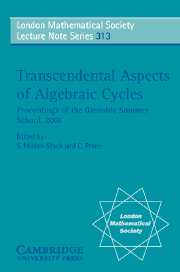3 - Topological properties of the algebraic cycles functor
from Part II - Lawson (co)homology
Published online by Cambridge University Press: 07 May 2010
Summary
Introduction
In this survey, we present various applications of algebraic cycles, considered as a topological group functor, to the study of complex algebraic varieties. In the classical literature in algebraic geometry, one can already find a vast number of results and techniques that can be considered as precursors of the approach presented here. For example, the study of divisors on Riemann surfaces, Picard groups and Albanese varieties [GH78], Abel–Jacobi maps and generalized Jacobians [Gri68], [Kin83], all contain manifestations of many phenomena that occur when one studies algebraic cycles varying continuously on a family. In the theory presented here, many of these classical ideas are combined with homotopy theory techniques to create the appropriate framework for our study.
The approach used here was introduced in the pioneering work of Lawson [Law89], whose main objective was to prove his complex suspension theorem (see Theorem 3.3.11) and, in particular, to compute the homotopy type of algebraic cycles on projective spaces. However, the techniques and ideas introduced in this paper went far beyond these results. In fact, the ‘complex suspension theorem’ itself was a disguised form of a homotopy invariance (cf. Section 3.3.2). It was due to the insight of Friedlander [Fri91] that the techniques used in [Law89] were shown to yield highly non-trivial homology-like functors on projective varieties.
The basic premise is rather simple. Given an algebraic variety X, the group Zp(X) of algebraic p-cycles on X is the free abelian group generated by the irreducible p-dimensional subvarieties of X.
- Type
- Chapter
- Information
- Transcendental Aspects of Algebraic CyclesProceedings of the Grenoble Summer School, 2001, pp. 75 - 120Publisher: Cambridge University PressPrint publication year: 2004
- 2
- Cited by

